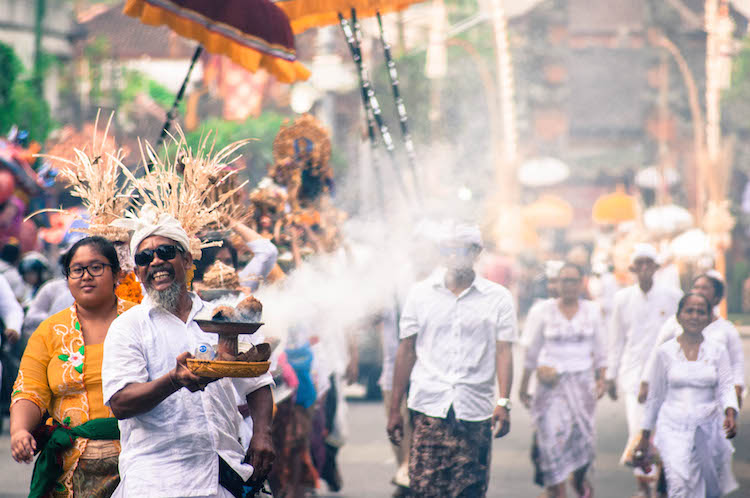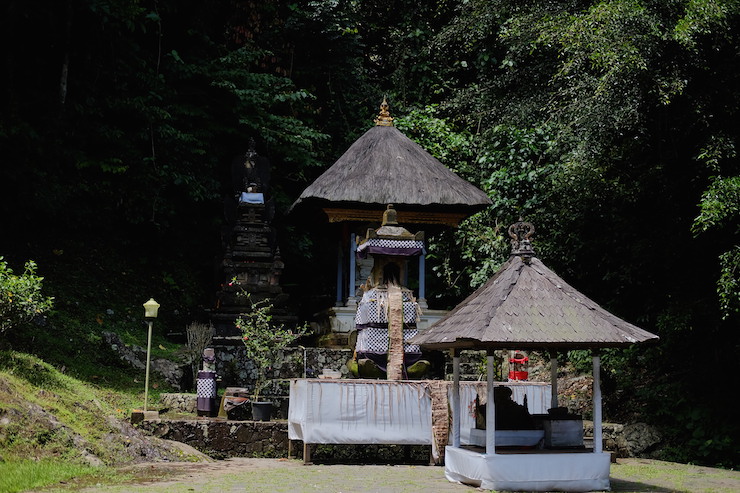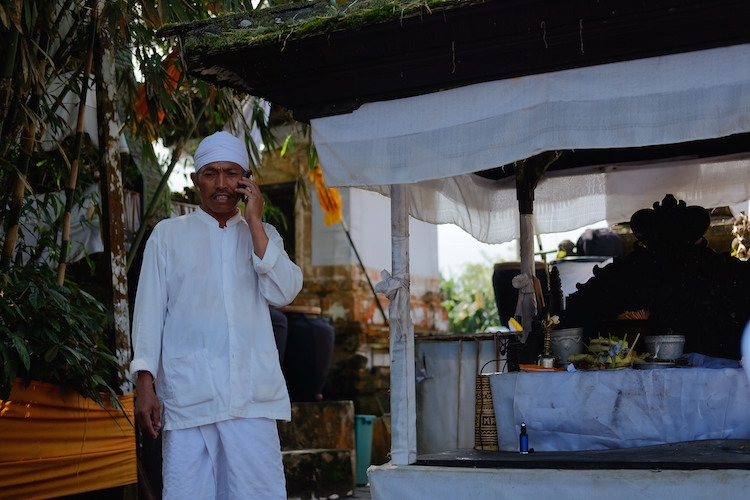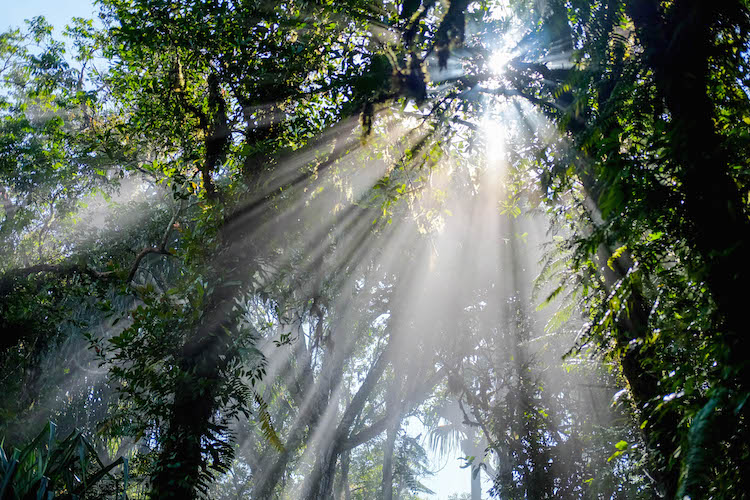When we talk about Balinese religion, we tend to immobilise it into intemporality, as if the kind of religious belief and practice that existed 100 years ago when the Dutch took over Bali, was still valid today. Of course the Balinese continue referring to a belief system that combines cult of ancestors and natural forces with a cosmological understanding of the world inspired by Indian thought.
Thus, after death, the soul of the dead hovers over the mountains in the so-called “Old Country”, waiting for the right time to reincarnate among its descendants. But changes have been underway since the Dutch took-over, and even more since Bali’s accelerated insertion through tourism in the modern global world, are of a such scope that Balinese religion may soon become unrecognisable…

A lot of factors are at work in those changes. The primary one is probably the collapse of the agrarian culture. Indeed there is still an extraordinary resilience of the cultural-religious side of this tradition. People are still linked to their village of origin where they go back for cremations and temple festivals: it is where their ancestors originate. We even witness, since 40 years or so,an extraordinary outpouring of ritual enthusiasm, as villages, clans and families compete with one another on who will put up the biggest cremation, and which village comes up with the most colourful temple ceremonies. But this is a paradoxical effect of tourism: the money earned in the tourism industry is flowing into villages. Hence the visual illusion of a cultural revival. But, at a deeper level, the cumulative changes induced by a combination of: accelerated urbanisation (55%), increased education standards, globalised communication and generalised commodification are quickly bringing about a complete revamping of the look, content social scope of Balinese religion.

Originally, the word Balinese “religion” had no precise meaning. Not yet conceptualised, this “religion” consisted of an amorphous compact of beliefs and traditions sometimes very different from one region and one caste or sub-caste to the other. The higher one’s caste –brahmana and satria—the more emphasis there was on the Indian-hued pantheon and “cosmology” if compared to native deities. Generally speaking, much attention was given to rites and offerings, and little to the query of truth. The religion was not even qualified as Hindu. It was called “the religion of water”, Agama Tirta.
It is where the biggest change is taking place. Following the setting up of the Council of Hindu Affairs (Parisada Hindu Dharma) in 1959, the religion of Bali has been totally reframed. Whereas the Oneness of God was heretofore of little importance, it became the first pillar of the faith, under the name of Sang Hyang Widdhi Wasa. All the deities, village ones, as well as “Indian” ones, found themselves reduced to being mere manifestations of the One God. At the same time, the Hindu theory of karma was given first rank, no mention being made to the fact that the Balinese traditionally reincarnate among their kin. Indeed, whereas Balinese tradition emphasised the ancestor’s cult, today’s official Hindu Dharma emphasises Hindu pantheistic cosmology. Balinese intellectuals have thus invented a genuine “theology”, and in doing so created a well-structured, logically articulated faith able to “compete” with Islam and Christianity .

Those changes at the level of religion proper did not remain the exclusive realm of intellectuals and priests. They took place alongside momentous changes in the way knowledge was being transmitted. Before the 1970s, not all children were schooled, and only a few beyond primary education. Their culture remained rooted in theatre and puppet shows, both of which were part of daily life. Their acculturation relied on “viewing” and “listening”, rather than on “reading” and “thinking”: it was therefore rich in symbols and “poor” in concepts and absolutist religious principles. This is changing very fast. Today’s young Balinese understanding of religion is increasingly articulated around what they “learn” at school and what they pick up in social medias. The theatre and its myths and stories, previously so overwhelming in their cultural memory, is now of marginal import. It is more the object of identity pride than of genuine knowledge. Another effect of schooling is the effect it has on prayers: sesonteng prayers in Balinese are rarely uttered any more. They are replaced by Kawi and Sanskrit (Indian) mantras and prayers. A shift in religion from “native Balinese” to “mainstream Hindu” is slowly taking place. Rather than looking for religious inspiration in their old Balinese manuscripts, modern Balinese intellectuals increasingly borrow ideas and beliefs from Indian books. The religion of Bali is thus slowly crystallising into a more and more Indianised Hinduism –with an ever present, but also every decreasing Balinese flavour.
As this religious revolution is taking place, the scope of religious identity is changing. The Balinese are usually proud of the variety of their village traditions. But as the innumerable deities of their villages are turned into mere “manifestations of God”, and as offerings are interpreted as simple “means of access” to God, they both lose their magical, irrational appeal. Hence a demand, for an ever more abstract system of belief, and for a “direct” rather than a magic-heavy contact between the self and God. Religious practice becomes in the process more and more individualised. Scorn toward tradition ensues. Urbanised people, far from the pressure of peers in their village of origin, and ever better educated, yearn for an ever more rational Hinduism. Hence the success of various Bakti movements, as well as of sects such as Sai Baba and Hare Krishna. People are becoming “believers”.

This does not go without its contradictions and risks. Until perhaps twenty years ago, with a lower level of education and urbanisation, and apart for a small number of privileged intellectuals, the Balinese did not primarily identify as “being Balinese”. They identified as members of a village congregation with its related rights and duties. Their identity was focused on locality. Hinduism was a “far away” word meaningful to only a minority of them. And “being Balinese” was not pinpointed as being of paramount importance. But today, especially since the Kuta 2002 bombing, and even though the Balinese have become more and more informed about the world, the main focus of their identity has shifted toward being, primarily, “Hindu” and Pan-Balinese.
In short, as the Balinese become more and more busy with the Oneness of God and its demands, their religion tends to become more and more political. Doesn’t it remind you of something?






